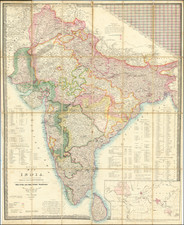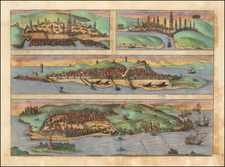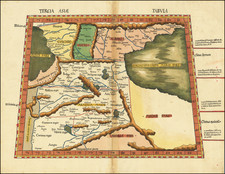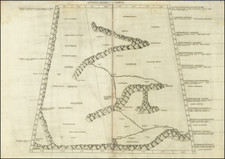Used By A British Military Officer In the Field
Rare large format map of Western India, with parts of Afghanistan and Pakistan, published in London and engraved by J & C. Walker.
The map bears the ownership markings of Lt-General Sir Frederick William Traill-Burroughs (biography below), who has added a pencil note below the publisher's name: "A New Map Published in 1863 - Get it!"
The map would seem to have been updated every few years and widely advertising by the publisher, although it is now quite rare.
States & Rarity
The map is very rare. OCLC notes no examples of the 1857 state of the map. OCLC lists an 1842 state (2 copies - British Library and National Library of Scotland) and 1852 state (1 copy, British Library). The Catalog of the India Room (1878) also listed an edition of 1850 and we note advertising for an 1846 edition.
Provenance: Sir Frederick William Traill-Burroughs, 93rd (Sunderland Highlanders) Regiment of Foot.
Lt-General Sir Frederick William Traill-Burroughs KCB CMG (1831 – 9 April 1905) was a British army officer. He was born in near Cawnpore, India.
Burroughs joined the 2nd Battalion 93rd (Sutherland Highlanders) Regiment of Foot, as an ensign in 1848. He served throughout the Crimean War with his Regiment, fighting at the Battle of Alma and the Battle of Balaclava where the 93rd were part of The Thin Red Line. The Regiment was in the front line at Sebastopol when the war ended. They were preparing to assault the town - it is said with Burroughs leading the first wave of the Highland Brigade - but discovered next morning that the enemy had withdrawn during the previous night, so he missed his moment of potential glory.
Burroughs was also one of the first - if not the very first - through the breaches at the besieged town of Lucknow in the Indian Rebellion of 1857, for which he was recommended by the men of his Regiment for a Victoria Cross, although due to internal military politics this was not awarded.
In 1864 he was promoted to Lieutenant-Colonel and commanded the Regiment in bitter fighting on the North West Frontier, particularly during the Ambela Campaign. He returned home with the Regiment in 1870 and after a spell in command at Edinburgh Castle he eventually retired from the army in 1873.
From 1897-1904, he was Colonel-in-Chief of the Royal Warwickshire Fusiliers.
On his return from India, he visited Rousay, Orkney, where he built a large house at Trumland; he had inherited much of the island and gradually bought more of it, carrying out many improvements.











![Carte de la Turquie, de l'Arabie et de la Perse, dressée sur les mémoires les plus récents rectifiée par les observations de Messieurs de l'Académie Royale des Sciences par G. de L'Isle, géographe. [Map of Turkey, Arabia, and Persia, drawn up based on the most recent memoirs and corrected by the observations of the gentlemen of the Royal Academy of Sciences by G. de L'Isle, geographer.]](https://storage.googleapis.com/raremaps/img/small/94075.jpg)



![L'Empire Des Turcs, En Europe, En Asie, et En Afrique . . . [includes Cyprus]](https://storage.googleapis.com/raremaps/img/small/71795.jpg)
